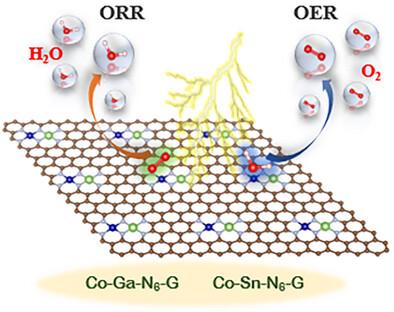Modeling Bifunctional Electrocatalysts Through p-Block Metal Incorporation in Transition Metal Doped N-Graphene for Oxygen Evolution and Reduction Reactions
IF 12.1
2区 材料科学
Q1 CHEMISTRY, MULTIDISCIPLINARY
引用次数: 0
Abstract
Development of efficient bifunctional electrocatalysts for the oxygen evolution reaction (OER) and oxygen reduction reaction (ORR) is essential for renewable energy storage and conversion technologies. While transition metal (TM) co-doped N-doped graphene systems (TM-N-G) are well-known for their electrocatalytic performance, their bifunctional activity for both OER and ORR remains limited and inefficient. In this work, bifunctional electrocatalytic performance of TM-N6-G systems (TM = Fe, Co, and Ni) is investigated by incorporating p-block metals (PM = Al, Ga, In, Sn, and Bi) into an N4 cavity, resulting in TM-PM-N6-G structures. Systematic DFT calculations reveal that among all the system configurations, Co-Ga-N6-G and Co-Sn-N6-G emerge as highly efficient bifunctional catalysts. The enhanced catalytic activity of Co centres is attributed to optimal interactions with reaction intermediates, as elucidated by scaling relations, volcano plots, and contour maps. These optimal interactions are explained by changes in electronic structure of catalysts and charge redistribution at the TM sites, induced by incorporated PMs. A new descriptor ϒ is proposed to describe the catalytic activity, performing better than conventional d-band center. Additionally, several unifunctional catalysts are identified. This detailed analysis provides key insights and design strategies for developing high-performance bifunctional catalysts via PM doping in TM-N-G systems.

通过p嵌段金属掺入过渡金属掺杂n -石墨烯模拟双功能电催化剂的析氧和还原反应
为析氧反应(OER)和氧还原反应(ORR)开发高效的双功能电催化剂对可再生能源的储存和转化技术至关重要。虽然过渡金属(TM)共掺杂n掺杂石墨烯体系(TM- n - g)以其电催化性能而闻名,但它们对OER和ORR的双功能活性仍然有限且效率低下。在这项工作中,通过将p嵌段金属(PM = Al, Ga, In, Sn和Bi)掺入N4腔中,从而产生TM-PM- n6 - g结构,研究了TM- n6 - g体系(TM = Fe, Co和Ni)的双功能电催化性能。系统DFT计算表明,在所有体系构型中,Co-Ga-N6-G和Co-Sn-N6-G是高效的双功能催化剂。Co中心的催化活性增强归因于与反应中间体的最佳相互作用,如标度关系、火山图和等高线图所阐明的那样。这些最佳的相互作用是由催化剂的电子结构变化和由掺入的pm引起的TM位点的电荷再分配来解释的。提出了一个新的描述词y来描述催化活性,表现优于传统的d波段中心。此外,还鉴定了几种功能催化剂。这一详细的分析为通过PM掺杂TM-N-G体系开发高性能双功能催化剂提供了关键的见解和设计策略。
本文章由计算机程序翻译,如有差异,请以英文原文为准。
求助全文
约1分钟内获得全文
求助全文
来源期刊

Small
工程技术-材料科学:综合
CiteScore
17.70
自引率
3.80%
发文量
1830
审稿时长
2.1 months
期刊介绍:
Small serves as an exceptional platform for both experimental and theoretical studies in fundamental and applied interdisciplinary research at the nano- and microscale. The journal offers a compelling mix of peer-reviewed Research Articles, Reviews, Perspectives, and Comments.
With a remarkable 2022 Journal Impact Factor of 13.3 (Journal Citation Reports from Clarivate Analytics, 2023), Small remains among the top multidisciplinary journals, covering a wide range of topics at the interface of materials science, chemistry, physics, engineering, medicine, and biology.
Small's readership includes biochemists, biologists, biomedical scientists, chemists, engineers, information technologists, materials scientists, physicists, and theoreticians alike.
 求助内容:
求助内容: 应助结果提醒方式:
应助结果提醒方式:


